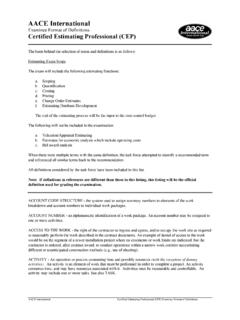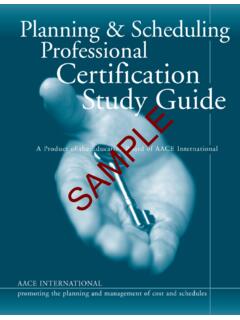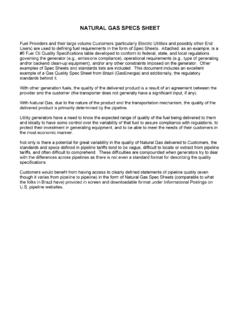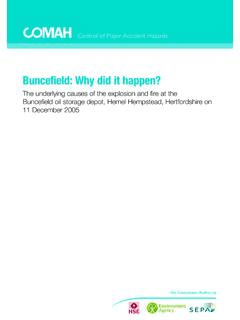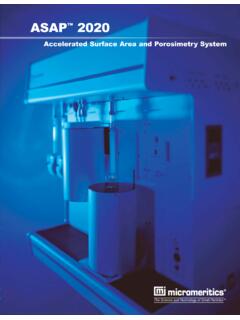Transcription of 18R-97: Cost Estimate Classification System – As Applied ...
1 18R-97 COST Estimate CLASSIFICATIONSYSTEM - AS Applied INENGINEERING, PROCUREMENT,AND CONSTRUCTION FOR THEPROCESS INDUSTRIESSAMPLE Copyright AACE International AACE International Recommended Practices Single user license only. Copying and networking prohibited. This document is copyrighted by AACE International and may not be reproduced without permission. Organizations may obtain permission to reproduce a limited number of copies by entering into a license agreement. For information please contact AACE International Recommended Practice No. 18R-97 COST Estimate Classification System AS Applied IN ENGINEERING, PROCUREMENT, AND CONSTRUCTION FOR THE PROCESS INDUSTRIES TCM Framework: Cost Estimating and Budgeting Rev. August 7, 2020 Note: As AACE International Recommended Practices evolve over time, please refer to for the latest revisions.
2 Any terms found in AACE Recommended Practice 10S-90, Cost Engineering Terminology, supersede terms defined in other AACE work products, including but not limited to, other recommended practices, the Total Cost Management Framework, and Skills & Knowledge of Cost Engineering. Contributors: Disclaimer: The content provided by the contributors to this recommended practice is their own and does not necessarily reflect that of their employers, unless otherwise stated. August 7, 2020 Revision: Peter R. Bredehoeft, Jr. CEP FAACE (Primary Contributor) Larry R. Dysert, CCP CEP DRMP FAACE Hon. Life (Primary Contributor) John K. Hollmann, PE CCP CEP DRMP FAACE Hon. Life (Primary Contributor) Todd W. Pickett, CCP CEP (Primary Contributor) March 6, 2019 Revision: Peter R. Bredehoeft, Jr. CEP FAACE (Primary Contributor) Larry R. Dysert, CCP CEP DRMP FAACE Hon.
3 Life (Primary Contributor) John K. Hollmann, CCP CEP DRMP FAACE Hon. Life (Primary Contributor) March 1, 2016 Revision: Larry R. Dysert, CCP CEP DRMP (Primary Contributor) Laurie S. Bowman, CCP DRMP EVP PSP Peter R. Bredehoeft, Jr. CEP Dan Melamed, CCP EVP Todd W. Pickett, CCP CEP Richard C. Plumery, EVP November 29, 2011 Revision: Peter Christensen, CCE (Primary Contributor) Larry R. Dysert, CCC CEP (Primary Contributor) Jennifer Bates, CCE Jeffery J. Borowicz, CCE CEP PSP Peter R. Bredehoeft, Jr. CEP Robert B. Brown, PE Dorothy J. Burton Robert C. Creese, PE CCE John K. Hollmann, PE CCE CEP Kenneth K. Humphreys, PE CCE Donald F. McDonald, Jr. PE CCE PSP C. Arthur Miller Todd W. Pickett, CCC CEP Bernard A. Pietlock, CCC CEP SAMPLEAACE International Recommended Practice No. 18R-97 COST Estimate Classification System AS Applied IN ENGINEERING, PROCUREMENT, AND CONSTRUCTION FOR THE PROCESS INDUSTRIES TCM Framework: Cost Estimating and Budgeting August 7, 2020 Copyright AACE International AACE International Recommended Practices Single user license only.
4 Copying and networking prohibited. TABLE OF CONTENTS Table of Contents .. 1 1. Purpose .. 1 2. Introduction .. 2 3. Cost Estimate Classification Matrix for the Process Industries .. 3 4. Determination of the Cost Estimate Class .. 5 5. Characteristics of the Estimate Classes .. 6 6. Estimate Input Checklist and Maturity Matrix .. 12 7. Basis of Estimate Documentation .. 14 8. Project Definition Rating System .. 15 9. Classification for Long-Term Planning and Asset Life Cycle Cost Estimates .. 15 References .. 16 17 Appendix: Understanding Estimate Class and Cost Estimate Accuracy .. 19 1. PURPOSE As a recommended practice (RP) of AACE International, the Cost Estimate Classification System provides guidelines for applying the general principles of Estimate Classification to project cost estimates ( , cost estimates that are used to evaluate, approve, and/or fund projects).
5 The Cost Estimate Classification System maps the phases and stages of project cost estimating together with a generic project scope definition maturity and quality matrix, which can be Applied across a wide variety of industries and scope content. This recommended practice provides guidelines for applying the principles of Estimate Classification specifically to project estimates for engineering, procurement, and construction (EPC) work for the process industries. It supplements the generic cost Estimate Classification RP 17R-97[1] by providing: A section that further defines Classification concepts as they apply to the process industries. A chart that maps the extent and maturity of Estimate input information (project definition deliverables) against the class of Estimate . As with the generic RP, the intent of this document is to improve communications among all the stakeholders involved with preparing, evaluating, and using project cost estimates specifically for the process industries.
6 The overall purpose of this recommended practice is to provide the process industry with a project definition deliverable maturity matrix that is not provided in 17R-97. It also provides an approximate representation of the relationship of specific design input data and design deliverable maturity to the Estimate accuracy and methodology used to produce the cost Estimate . The Estimate accuracy range is driven by many other variables and risks, so the maturity and quality of the scope definition available at the time of the Estimate is not the sole determinate of accuracy; risk analysis is required for that purpose. SAMPLE18R-97: Cost Estimate Classification System As Applied in Engineering, Procurement, and Construction for the Process Industries 2 of 21 August 7, 2020 Copyright AACE International AACE International Recommended Practices Single user license only.
7 Copying and networking prohibited. This document is intended to provide a guideline, not a standard. It is understood that each enterprise may have its own project and estimating processes, terminology, and may classify estimates in other ways. This guideline provides a generic and generally acceptable Classification System for the process industries that can be used as a basis to compare against. This recommended practice should allow each user to better assess, define, and communicate their own processes and standards in the light of generally-accepted cost engineering practice. 2. INTRODUCTION For the purposes of this document, the term process industries is assumed to include firms involved with the manufacturing and production of chemicals, petrochemicals, and hydrocarbon processing.
8 The common thread among these industries (for the purpose of Estimate Classification ) is their reliance on process flow diagrams (PFDs), piping and instrument diagrams (P&IDs), and electrical one-line drawings as primary scope defining documents. These documents are key deliverables in determining the degree of project definition, and thus the extent and maturity of Estimate input information. This RP applies to a variety of project delivery methods such as traditional design-bid-build (DBB), design-build (DB), construction management for fee (CM-fee), construction management at risk (CM-at risk), and private-public partnerships (PPP) contracting methods. Estimates for process facilities center on mechanical and chemical process equipment, and they have significant amounts of piping, instrumentation, and process controls involved.
9 As such, this recommended practice may apply to portions of other industries, such as pharmaceutical, utility, water treatment, metallurgical, converting, and similar industries. Most plants also have significant electrical power equipment ( , transformers, switchgear, etc.) associated with them. As such, this RP also applies to electrical substation projects, either associated with the process plant, as part of power transmission or distribution infrastructure, or supporting the power needs of other facilities. This RP excludes power generating facilities and high-voltage transmission. This RP specifically does not address cost Estimate Classification in non-process industries such as commercial building construction, environmental remediation, transportation infrastructure, hydropower, dry processes such as assembly and manufacturing, soft asset production such as software development, and similar industries.
10 It also does not specifically address estimates for the exploration, production, or transportation of mining or hydrocarbon materials, although it may apply to some of the intermediate processing steps in these systems. The cost estimates covered by this RP are for engineering, procurement, and construction (EPC) work only. It does not cover estimates for the products manufactured by the process facilities, or for research and development work in support of the process industries. This guideline does not cover the significant building construction that may be a part of process plants. This guideline reflects generally-accepted cost engineering practices. This recommended practice was based upon the practices of a wide range of companies in the process industries from around the world, as well as published references and standards.


